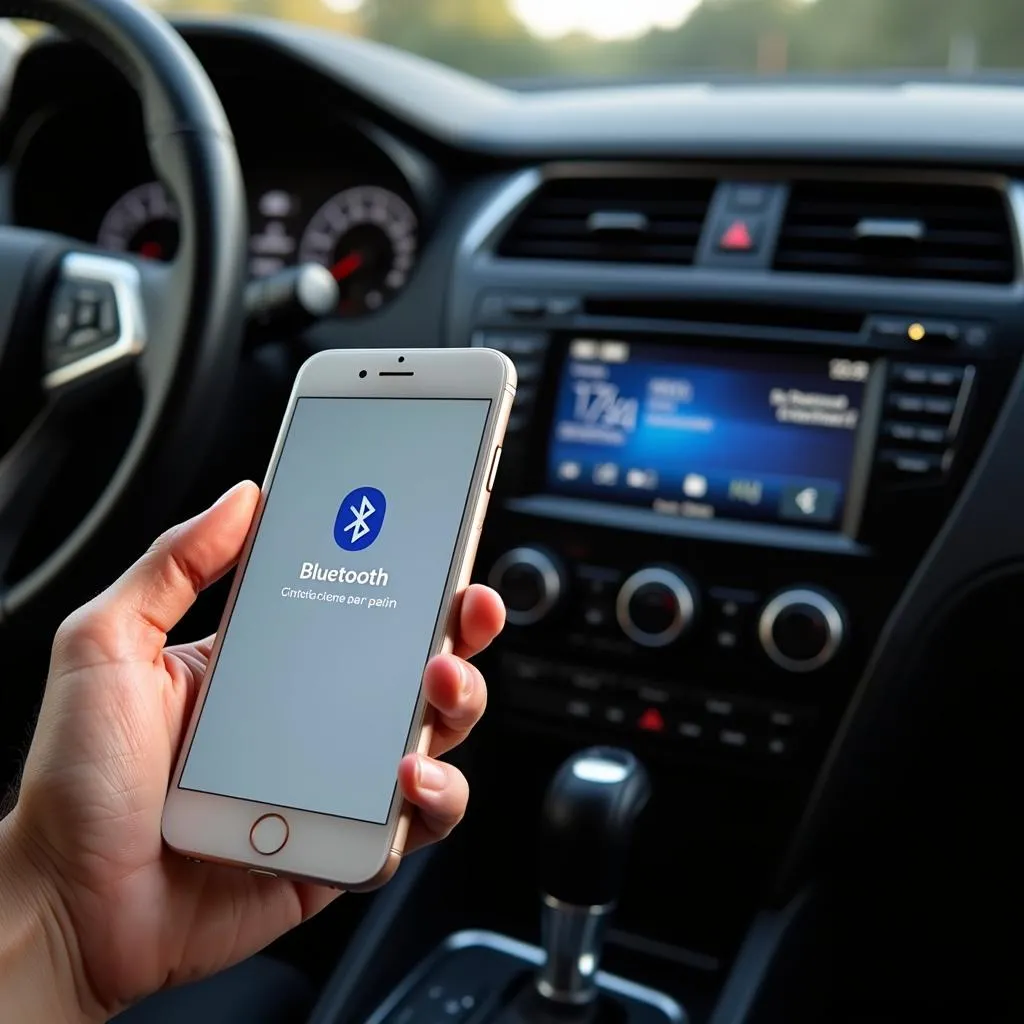Connecting your phone to your car radio opens a world of entertainment and hands-free communication. While Bluetooth is the most common method, there are times when you need to manually connect your phone to your car radio without Bluetooth. This guide provides a comprehensive overview of various methods to achieve this, ensuring you can enjoy your favorite tunes and stay connected on the road. Learn the ins and outs of auxiliary cables, USB connections, cassette adapters, and even FM transmitters, enabling you to choose the best solution for your specific needs. radio car bluetooth
Understanding Your Options: A Deep Dive into Manual Connections
Let’s explore the different ways you can manually connect your phone to your car radio, highlighting the pros and cons of each method. Each connection type offers unique advantages and disadvantages, making it crucial to choose the one that best suits your vehicle and phone.
Auxiliary Cable (AUX): The Simplest Solution
The most straightforward method is using a 3.5mm auxiliary cable. Simply plug one end into your phone’s headphone jack and the other into the AUX input of your car radio. This method is widely compatible and provides decent sound quality. However, it lacks the hands-free calling functionality of Bluetooth.
USB Connection: For Data and Charging
If your car radio has a USB port, you can use a USB cable to connect your phone. This method often allows for charging your phone while playing music. Some car radios may even offer control over your phone’s music library directly from the radio interface. However, compatibility can vary between car models and phone operating systems.
Cassette Adapter: A Blast from the Past
For older cars with cassette players, a cassette adapter is a viable option. This adapter mimics a cassette tape, allowing you to connect your phone via the headphone jack. While it’s a cost-effective solution, the sound quality may be less than ideal due to the analog nature of the connection.
FM Transmitter: Broadcasting Your Tunes
An FM transmitter broadcasts your phone’s audio over a designated FM frequency. You tune your car radio to this frequency to listen to your music. While convenient, sound quality can be affected by radio interference, especially in urban areas.
“In my experience, the auxiliary cable offers the most reliable sound quality for manual connections,” says Michael Johnson, Senior Automotive Electrical Engineer at AutoTech Solutions. “While USB offers additional features, compatibility can be a concern.”
Troubleshooting Common Connection Issues
Sometimes, even with the right cables and connections, you might encounter issues. Here’s a step-by-step guide to troubleshoot common problems:
- Check the Volume: Ensure the volume on both your phone and car radio is turned up.
- Verify the Connection: Double-check that all cables are securely plugged into the correct ports.
- Select the Correct Input Source: On your car radio, select the appropriate input source (AUX, USB, etc.) corresponding to your chosen connection method.
- Restart Devices: Try restarting both your phone and car radio.
 Troubleshooting Car Radio Connection Problems
Troubleshooting Car Radio Connection Problems
“Remember to always consult your car’s manual for specific instructions regarding your radio and available connection options,” advises Sarah Thompson, Lead Diagnostic Technician at CarDiagNow.
connect iphone bluetooth to car radio
Choosing the Right Connection for Your Needs
The best method to manually connect your phone to your car radio without Bluetooth depends on your individual circumstances. Consider factors such as sound quality, available ports on your car radio, budget, and desired features.
Manually Connecting Your Phone: A Step-by-Step Example using an AUX Cable
- Locate the 3.5mm headphone jack on your phone and the AUX input on your car radio.
- Plug one end of the auxiliary cable into your phone’s headphone jack.
- Plug the other end of the cable into the car radio’s AUX input.
- Select the AUX input source on your car radio.
- Play music on your phone and adjust the volume on both devices.
In conclusion, manually connecting your phone to your car radio without Bluetooth is entirely possible, offering several viable options. By understanding the different methods available and following the troubleshooting tips provided, you can enjoy your music and stay connected on the go. Choosing the right method depends on your specific needs and car’s capabilities, ensuring a seamless and enjoyable listening experience. Remember to explore the various options outlined in this guide to manually connect your phone to car radio without bluetooth and choose the one that best fits your situation.
FAQ
- Why would I want to connect my phone to my car radio manually without Bluetooth? Bluetooth isn’t always available, especially in older cars. Manual connections provide a reliable alternative.
- What is the cheapest way to manually connect my phone to my car radio? An auxiliary cable is generally the most affordable option.
- Which manual connection method provides the best sound quality? An auxiliary cable usually provides the most consistent sound quality.
- Can I charge my phone while using a manual connection? Yes, if you connect via a USB port that supports charging.
- How do I troubleshoot if my phone isn’t playing through the car radio? Check the volume, connection, input source, and try restarting your devices.
- What if my car doesn’t have an AUX input? Consider using a cassette adapter or FM transmitter.
- Where can I buy the cables and adapters needed for manual connections? Electronics stores, online retailers, and even gas stations often carry these items.


